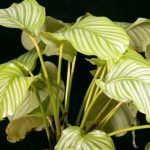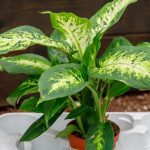- TEMPERATURE: 60 – 75 degrees F 18 – 24 degrees C)
- LIGHT: Low to medium, indirect
- HUMIDITY: High
- SAFETY: Nontoxic to cats and dogs
- DIFFICULTY: Moderate
Calathea ornata, also known as Pinstripe Plant, is commonly thought to be a prayer plant. While they are related and both prized for their beautiful foliage, Calathea is a bit harder to grow than its cousin. I would not consider this a beginner’s houseplant.
While the pinstripe plant isn’t necessarily hard to grow, it does have high humidity requirements and needs a special soil mixture. If you live in a dry area (like me), you may struggle to keep this moisture-loving tropical plant happy.
The dark-green, pink-striped leaves, from which the plant gets its common name, are Calathea ornata’s main attraction. The underside of the leaves are burgundy in color and quite striking. The plant reaches up to 2 feet tall (0.6 m) with proper care.
Water
Keep the soil evenly moist at all times – not wet, but never dry. If the soil feels dry to the touch, it’s time to water. Check every few days to avoid under-watering. Water with tepid water, as water that’s too cold can shock the roots.
Calathea ornata is also affected by the fluoride in water. If you live in an area where it’s added to the tap water, use distilled, rain, or spring water instead. For my fluoride-sensitive plants, I keep a jug of distilled water out on the counter at room temperature for watering.
Humidity
Pinstripe plant needs high humidity. Originating in the tropical forests of the Amazon jungle, it thrives in shady, damp conditions.
Place your plant on a pebble tray and place it near a high quality houseplant humidifier. Mist several times a day with a spray bottle filled with distilled water and surround the pot with damp peat moss. This is a necessity, as low humidity causes leaf edges to brown or leaves to drop.
If you’re unsure about humidifiers, you can read my review of my favorite houseplant humidifier (the one I’m using right now) or click here to view it directly on Amazon.
Fertilizer
Feed Calathea ornata using a well-balanced houseplant fertilizer once a month during spring through fall. Do not feed in the winter months.
My favorite fertilizer is Jack’s All-Purpose, but any all-purpose food will work. (Read my review of Jack’s Fertilizer to see why I love it so much.) I use it on all my houseplants, except those that need special nutrients like cacti and succulents.
Light
Calathea ornata cannot tolerate direct sunlight. It will fade the beautiful pinstripes on its leaves. However, too little light will not allow the colors to remain bright. For the best results, place in a well-lit area that does not receive any direct sun.
A north- or south-facing window is ideal in winter. During spring and summer, place 3 – 5 feet back from an east- or west-facing window if you like. As long as you keep it out of direct sun, you should be fine. Too long in the sun could be fatal.
Temperature
Pinstripe plant likes warm temperatures. Never allow the temperature to drop below 60 degrees F (15 degrees C). For the best results, keep temperatures between 65 – 75 degrees F (18 – 24 degrees C) all year long.
Sudden fluctuations in temperature can harm delicate Calathea ornata leaves. Keep your plant away from drafts and blasts of air from heating/cooling vents.
Potting
Repot Calathea ornata in spring every two years. Choose a pot 2 inches (5 cm) in diameter larger than the previous container.
This plant needs a special soil mixture that you’ll have to mix up yourself (at least I’ve never seen a commercial mixture available that meets the plant’s needs). Here’s the recipe I use:
Calathea Soil Mix
- 50 percent potting soil
- 20 percent orchid bark
- 20 percent charcoal
- 10 percent perlite
Use any high-quality potting soil formulated for houseplants in the recipe above. I like this one by Happy Frog because it contains mycorrhizal fungi and beneficial soil microbes, but any good-quality potting mix will work.
Propagation
Calathea is best propagated by division. Divide your plants at repotting time, then place the divided plants into their own pots. Keep warm and moist until the new plants are established.
Maintenance
Pinstripe plant requires very little maintenance aside from its basic care. Clean leaves with a soft cloth if they get dirty, and remove any dead or dying leaves as needed.
Troubleshooting
Here are some common problems indoor gardeners have with Calathea ornata and solutions:
- Brown Leaf Edges – If leaf edges are turning brown, the air is too dry. Increase humidity by placing the plant on a humidity tray, placing next to a high quality humidifier, and/or misting regularly with distilled water. This can also be caused by fluoride in tap water.
- Faded Leaves & Colors – If the colors on the leaves begin to fade, you’re giving the plant too much sunlight. Move to a well-lit area, but make sure the plant does not receive any direct sun.
- Lower Leaves Turning Yellow – If the lower leaves of your Calathea ornata are turning yellow, it’s usually due to under-watering. Unlike many other houseplants, this one does NOT like to dry out between waterings. Keep the soil moist at all times.
- Leaves Dropping – If your leaves are dropping or falling off, the air is too dry. Increase humidity by placing the plant on a humidity tray, placing next to a high quality humidifier, and/or misting regularly with distilled water.
- Leaves Curling – Calathea leaves curling is also caused by dry air. Increase humidity by the methods discussed above, and see my post on how to fix calathea leaves curling for more information.
Where to Buy Calathea Ornata
If you’re lucky, you may find Calathea ornata at your local nursery or garden center. I’ve never had any luck finding it locally, but I also live in an arid climate. If you live in a more tropical climate, you might have better luck.
When I can’t find plants locally, I always check on Etsy. I love buying plants from Etsy because small growers care more about the quality of their plants than large corporate nurseries. They have a reputation to protect and typically ship very high-quality specimens.
Click here to see the current listings for Calathea ornata on Etsy. Happy plant shopping!





